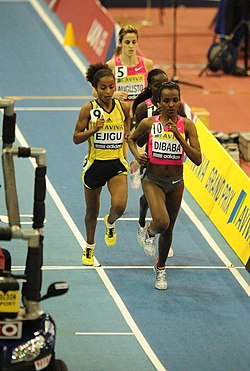
Back 3.000 metros lisos AN 3000 متر Arabic 3.000 metres Catalan Běh na 3000 metrů Czech 3000-meterløb (atletik) Danish 3000-Meter-Lauf German 3000 metros Spanish 3000 meetri jooks Estonian 3000 metroko lasterketa Basque دو ۳۰۰۰ متر Persian
| Athletics 3000 metres | |
|---|---|
 | |
| World records | |
| Men | |
| Women | |
| Short track world records | |
| Men | |
| Women | |
| World junior (U20) records | |
| Men | |
| Women | |
The 3000 metres or 3000-metre run is a track running event, also commonly known as the "3K" or "3K run", where 7.5 laps are run around an outdoor 400 m track, or 15 laps around a 200 m indoor track.
It is debated whether the 3000m should be classified as a middle-distance or long-distance event.[1] In elite-level competition, 3000 m pace is more comparable to the pace found in the longer 5000 metres event, rather than mile pace. The world record performance for 3000 m equates to a pace of 58.76 seconds per 400 m, which is closer to the 60.43 seconds for 5000 m than the 55.46 seconds for the mile. However, the 3000 m does require some anaerobic conditioning, and an elite athlete needs to develop a high tolerance to lactic acid, as does the mile runner. Thus, the 3000 m demands a balance of aerobic endurance needed for the 5000 m and lactic acid tolerance needed for the Mile.
In men's athletics, 3000 metres has been an Olympic discipline only as a team race at the 1912, 1920 and 1924 Summer Olympics. It has not been contested at any of the IAAF outdoor championships, but is occasionally hosted at annual elite track and field meetings. It is often featured in indoor track and field programmes and is the longest-distance event present at the IAAF World Indoor Championships.
In women's athletics, 3000 metres was a standard event in the Olympic Games (1984 to 1992)[2] and World Championships (1980 to 1993).[3] The event was discontinued at World Championship and Olympic level after the 1993 World Championships in Athletics – Qu Yunxia being the final gold medal winner at the event. Starting with the 1995 World Championships in Athletics and the 1996 Olympic Games, it was replaced by 5000 metres, with other IAAF-organized championships following suit.
Skilled runners in this event reach speeds near vVO2max, for which the oxygen requirements of the body cannot continuously be satisfied,[4] requiring some anaerobic effort.[further explanation needed]
- ^ Middle-distance running. Encyclopædia Britannica. Retrieved on 2014-06-02.
- ^ Women's 3000 metres at the Olympic Games. Sport Reference. Retrieved on 2014-01-18.
- ^ World Championships in Athletics. GBR Athletics. Retrieved on 2014-01-18.
- ^ Billat, Véronique L.; J. Pierre Koralsztein (August 1996). "Significance of the Velocity at VO2max and Time to Exhaustion at this Velocity" (PDF). Sports Med. 2: 90–108. Archived from the original (PDF) on 21 March 2012. Retrieved 27 March 2011.